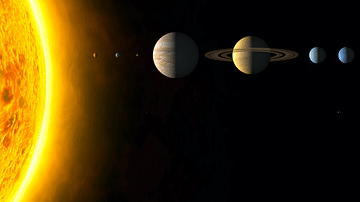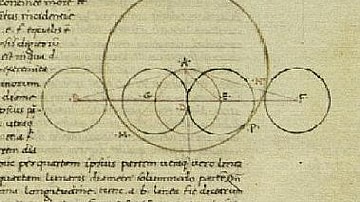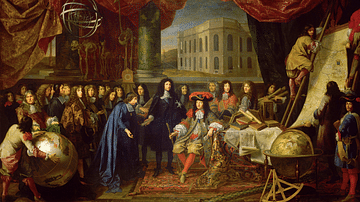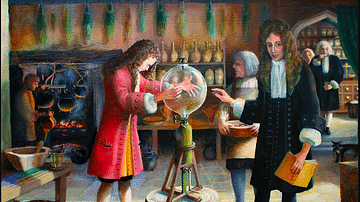
The Scientific Revolution (1500-1700), which occurred first in Europe before spreading worldwide, witnessed a new approach to knowledge gathering – the scientific method – which utilised new technologies like the telescope to observe, measure, and test things never seen before. Thanks to the development of dedicated institutions, scientists conducted yet more experiments and shared their knowledge, making it ever more accurate. By the end of this 'revolution', science had replaced philosophy as the dominant method of acquiring new knowledge and improving the human condition.
Defining a 'Revolution'
Dating the beginning and end of the Scientific Revolution is problematic. Historians do not all agree on precise dates as the 'revolution' was not a single dramatic event but, rather, a long and gradual series of discoveries and changes in attitudes to knowledge. The period of the 16th and 17th centuries as a whole generally covers most of the pertinent events and discoveries. There is also the problem of what to call these events. This was not a 'revolution' in the usual sense of the term, that is, a movement involving all classes, in all places, over a short space of time with a defined end goal which was ultimately achieved. Rather, from around 1500 to around 1700, there was a gradual but marked shift in how thinkers approached the acquisition of knowledge of the world around us. Modern historians often shy away from using such a dramatic term as 'revolution' to describe any deep change in human behaviour, since such a blanket term caries with it uncalled-for baggage of meanings and masks a number of anomalies, not least in this case that the 'revolution' was never complete or completed. That something momentous did occur is, however, clear from even the briefest assessment of how knowledge was gathered before and how it has been gathered ever since the Scientific Revolution.
Through the two centuries of the Scientific Revolution, natural philosophers who still adhered to ancient wisdom were slowly replaced in importance by practical scientists who used scientific instruments like the telescope and barometer to test their hypotheses and then share and review their findings. In this way, universal laws could be formed which were then further tested and used to predict outcomes in yet more experiments. Mathematics, in particular, came to dominate thought as more traditional methods of pursuing knowledge like magic, alchemy, and astrology were sidelined in favour of more objective, empirical, and evidence-based experimentation. In addition, the great trio of ancient thinkers who had held sway right through the Middle Ages – Aristotle (l. 384-322 BCE), Claudius Ptolemy (c. 100 to c. 170 CE), and Galen (129-216 CE) – were swept away as early modern minds finally looked to the future instead of the past.
Instruments like the pendulum clock and thermometer made it possible to accurately measure the world around us while optical instruments revealed things previously unimaginable such as the real nature of the surface of the Moon and the intricate anatomy of tiny insects. In all of these senses, then, there was indeed a 'revolution' that resulted in old theories, many of which had been held since antiquity as true, being cast aside and brand new ones replacing them based on new discoveries, new methodologies, and entirely new fields of study.

The Scientific Method
A distinctive feature of the change in thought during the Scientific Revolution was a reconsideration of how new knowledge should be acquired and tested. Practical experiments had been conducted ever since antiquity, but through the Middle Ages, a certain theoretical approach to knowledge, first pioneered by thinkers like Aristotle, had come to dominate. Verbal arguments had become more important than what could actually be seen in the world. Further, natural philosophers had become preoccupied with why things happen instead of first ascertaining what was actually happening in nature and how it was happening. One of the first to question this approach was the English statesman and philosopher Francis Bacon (1561-1626).
Bacon called for a more systematic and practical approach where empirical (observable) consequences of experiments were collated, assessed using reason, and then openly shared for review by other thinkers. The ultimate objective of this activity should be used to test the validity of existing knowledge and forge a new understanding of the world around us so that the human condition can be practically improved. For these reasons, Bacon is considered one of the founders of modern scientific research and scientific method, even as "the father of modern science". Bacon's approach did become a reality, but with important additions such as the use of a hypothesis as part of the experimental process, the application of mathematics to create universal laws, and the addition of new technology that greatly improved the senses.
The scientific method came to involve the following key components:
- conducting practical experiments
- conducting experiments without prejudice of what they should prove
- using deductive reasoning (creating a generalisation from specific examples) to form a hypothesis (untested theory), which is then tested by an experiment, after which the hypothesis might be accepted, altered, or rejected based on empirical (observable) evidence
- conducting multiple experiments and doing so in different places and by different people to confirm the reliability of the results
- an open and critical review of the results of an experiment by peers
- the formulation of universal laws (inductive reasoning or logic) using, for example, mathematics
- a desire to gain practical benefits from scientific experiments and a belief in the idea of scientific progress
(Note: the above criteria are expressed in modern linguistic terms, not necessarily those terms 17th-century scientists would have used since the revolution in science also caused a revolution in the language to describe it.)
Important Inventions
The Scientific Revolution witnessed a great number of new inventions, that is, technological innovations that allowed the new scientists to not only discover new things about the world but also ways to measure, test, and assess these new phenomena. The most important inventions in the Scientific Revolution include:
- the telescope (c. 1608)
- the microscope (c. 1610)
- the barometer (1643)
- the thermometer (c. 1650)
- the pendulum clock (1657)
- the air pump (1659)
- the balance spring watch (1675)
Important Discoveries
With the above inventions and others, scientists in many different countries made many new discoveries, and whole new specialisations of study became possible, such as meteorology, microscopic anatomy, embryology, and optics.
The Italian Galileo Galilei (1564-1642) built the most powerful of the early telescopes, and with it, he discovered the mountains and valleys of the Moon's surface, previously thought to be made of some unknown substance. Galileo identified four moons of the planet Jupiter and the phases of Venus. He observed sunspots, leading him to suggest the Sun was a turning sphere. The German Johannes Kepler (1571-1630) created a new type of telescope, which used two convex lenses, and he used it to observe the heavenly bodies and confirm the heliocentric view of our galaxy proposed by Nicolaus Copernicus (1473-1543 CE). At last, the geocentric model of Ptolemy was shown to be wrong. In addition, Kepler demonstrated that the planets moved in elliptical and not circular orbits.
The Italian astronomer Gian Domenico Cassini (1625-1712) identified the spaces in the rings of Saturn. Johannes Hevelius (1611-1687) in Danzig (modern Gdańsk) discovered the first variable star and created a detailed map of the Moon's surface. The English astronomer Edmond Halley (1656-1742) established an observatory on the island of St. Helena in the South Atlantic in 1677 and created the first chart of the southern stars using a telescope. Halley also discovered the acceleration of the Moon, noted the movement of the stars in relation to each other (proper motion), and identified the comet of 1682 as the same one of 1607 and 1531.
The English scientist Isaac Newton (1642-1727) invented the reflecting telescope in 1668, which used a curved mirror. Newton discovered that white light was made up of a spectrum of coloured light, and he formed his universal theory of gravity, which explained why objects fell on earth and why the heavenly bodies move as they do.
The invention of the microscope, in many ways the natural opposite of the telescope, is usually credited to the spectacle-maker Hans Lippershey (c. 1570 to c. 1619), then living in the Netherlands. The Italian Marcello Malpighi used a microscope to discover capillaries in the blood system in 1661. This was the missing link between arteries and veins, and it confirmed William Harvey's discovery of blood circulation. Galen's views of how the human body worked were now proven to be wholly inadequate or plain wrong.
The English experimentalist Robert Hooke (1635-1703) used his microscope to create sensational drawings of a new miniature world published in his Micrographia in 1665. The Dutchman Antonie van Leeuwenhoek (1632-1723) pioneered a new type of microscope using a glass bead as a lens, which gave him a much greater magnification than previously possible. Leeuwenhoek discovered bacteria, protozoa, red blood cells, spermatozoa, and how minute insects and parasites reproduce. Another Dutch microscopist, Jan Swammerdam (1637-1680), discovered that caterpillars contain what become the wings of the butterfly after metamorphosis. Finally, Nehemiah Grew (1641-1712) was the founder of plant anatomy based on his in-depth study of the sexual organs of plants.
The barometer was invented in 1643 by the Italian Evangelista Torricelli (1608-1647), and it allowed scientists to understand atmospheric pressure. The Frenchman Blaise Pascal (1623-1662) used a barometer to demonstrate that air pressure changes with altitude. The German Otto von Guericke (1602-1686) noted that air pressure varied depending on the weather. The barometer was actually named by the English scientist Robert Boyle (1627-1691), who also worked on air pumps. Boyle and his associate Robert Hooke were able to demonstrate how a vacuum could exist, and they subjected all manner of specimens to changes in air pressure inside their air pump. Boyle was thus able to formulate a universal principle that became known as 'Boyle's Law'. This law states that the pressure exerted by a certain quantity of air varies inversely in proportion to its volume (provided temperatures are constant).
A related device, the liquid thermometer, was invented in Florence around 1650, and it transformed medicine, allowing doctors to measure a patient's temperature beyond a mere 'hot', 'cold' or 'normal'. The device meant many other experiments could now be made and the results accurately measured and compared.
The first working model of the pendulum clock was invented by the Dutchman Christiaan Huygens (1629-1695) in 1657. In a pendulum clock, the regularity of the pendulum's swing precisely controls the falling of a weight. The best pendulum clocks lost a maximum of 15 seconds per day compared to 15 minutes with a mechanical clock. Timekeeping became even more accurate with the invention in 1675 of watches using a balance spring. This great leap forward in accuracy not only helped scientists better monitor their experiments and time their observations of objects in space but it also revolutionised the very idea of time for everyone. This was the first step towards having a universal time, and with it came the concepts of being early, on time, and late in daily life.
Institutionalised Science
Another key development of the Scientific Revolution, besides a new method and new technology, was the foundation of dedicated research bodies. At this time, universities (with the possible exception of departments of medicine) were not concerned with research, but only with teaching. A new type of institution was required where scientists could work together, share their findings, and, most importantly of all, receive funding for their work. These were the new academies and societies that sprang up across Europe. The first such society was the Academia del Cimento in Florence, founded in 1657. Others soon followed, notably the Royal Society in London in 1663 and the Royal Academy of Sciences in Paris in 1667. Those responsible for the foundation of the Royal Society credited Bacon with the idea, and they were keen to follow his principles of scientific method and his emphasis on sharing and communicating scientific data and results. The Berlin Academy was founded in 1700 and the St. Petersburg Academy in 1724. These academies and societies became the focal points of an international network of scientists who corresponded, read each other's works, and even visited each other's laboratories and observatories as the new scientific method took hold. The public was involved, too, either indirectly through access to published journals and books or directly with the opportunity to attend experiments and demonstrations in the societies' headquarters or out in the field.

That there was an increase in international cooperation in the Scientific Revolution is indicated in the invitation to non-nationals to become fellows of these societies. There were attempts to standardise certain experiments across borders and the instruments different scientists were using. For example, the German Daniel Gabriel Fahrenheit (1686-1736) devised his Fahrenheit scale for thermometers around 1714. Anders Celsius (1701-1744) from Sweden came up with a rival scale, but having two scales on thermometers was a vast improvement from the early days when scientists in different countries simply used their own scales, a situation that made comparisons of results extremely difficult. There was, too, cooperation between scientists despite them belonging to rival European empires, and it was through these colonial empires, especially the Dutch, French, and British, that the ideas of the Scientific Revolution spread far beyond Europe.
Reaction to the Scientific Method
The reaction to the Scientific Revolution was not all positive. Some intellectuals were sceptical that the new scientific instruments could be trusted. There remained sceptics of experimentation in general, those who stressed that the senses could be misled when the reason of the mind could not be. One such doubter was René Descartes (1596-1650), but if anything, he and other natural philosophers who questioned the value of the work of the practical experimenters were responsible for creating a lasting new division between philosophy and what we would today call science. The term "science" was still not widely used in the 17th century, instead, many experimenters referred to themselves as practitioners of "experimental philosophy". The first use in English of the term "experimental method" was in 1675. The development of these terms illustrates that a break was happening between theoretical and practical thinkers.
Some even questioned whether humanity should be delving into a previously unseen world, which they considered should remain God's affair. There was a clash between science and religion when it came to the view of how the universe was organised. Church figures preferred to hold on to the idea that the Earth and humanity must be at the centre of the universe, and so thinkers like Galileo, who supported Copernicus' heliocentric model, were found guilty of heresy. However, most scientists were Christians and had no wish to challenge the teaching of the Bible. Many scientists simply wanted to explain how the world was made as it is. Indeed, some argued that the telescope and microscope demonstrated just how intricate life is, and so one should, they thought, hold even more wonder at God's work.
There was still room for God in this new scientific world, since thinkers like Isaac Newton, for example, could only explain that gravity moved planets, he could not explain where gravity came from or why it existed. There were still many limits to human knowledge. Doctors now knew why certain diseases might come about but still had only limited knowledge of how to cure them. The great longitude problem of how navigators could track their position around the globe remained unsolved. Technology was still frustratingly limited in many areas.
Into the Future
New scientific instruments meant that discoveries came thick and fast, often causing bewilderment at just how complex life could be. Telescopes at one end of the scale and microscopes at the other revealed that a whole new system of measurement was required for the human mind to grasp the scale of the wonders of the visible universe. Previously, the human body had been used as a base of the measurement system, soon nanometers and light years would be required. There were momentous changes in how people of all classes viewed the new worlds opened up by the scientists. This is best seen in the popular fiction of the period, which began to discuss intriguing yet also troubling ideas like the infinity of the universe or that tiny parasites themselves had even smaller parasites, which themselves had yet smaller parasites. Could it be possible to one day travel to the Moon? Since the Earth was no longer the centre of the universe, did this not mean there could be other planets with other life forms?
There was, though, amongst this perplexity, a new confidence and belief, certainly amongst the scientists, that technology and science, given time, could provide all the answers humanity needed to live better, longer, and more happily. New clock mechanisms with their sophisticated gears, the use of pistons in air pumps, and the discovery of the power of air pressure all inspired engineers to invent new machines like the steam engine as another, even greater revolution, appeared on the horizon: the British Industrial Revolution.
The Scientific Revolution had another lasting effect, and that is the establishment of science as the most recognised method of finding truth, a position of dominance it still holds today. When we talk about theories, hypotheses, laws of nature, evidence, facts, and progress we use terms which were coined during the Scientific Revolution; to discuss knowledge today without using these terms is unthinkable, and there, perhaps, lies the true legacy of this revolution in ideas, methods, and technology.









